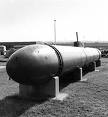|
Japanese Kaiten, a special attack submarine

By late 1944, the war situation had deteriorated for Japan to the point where extraordinary measures were seen as offering the only way out of an increasingly grim military predicament. Thus, with the invasion of the Philippines, the Japanese first formulated and implemented `Special Attack` tactics in the form of suicide aircraft attacks: the kamikazes. In short order, Japan began applying the same doctrine in the creation of new weapons systems. Notable among these was the Kaiten ("Turning of the Heavens") suicide submarine.
The Kaiten was aptly described by Theodore Cook as "not so much a ship as an insertion of a human being into a very large torpedo. The guts of the beast was a standard Type-93 24" torpedo, with the mid-section elongated to create the pilot`s space. He sat in a canvas chair practically on the deck of the Kaiten, a crude periscope directly in front of him, and the necessary controls close to hand in the cockpit. Access to the Kaiten was through hatches leading up from the sub and into the belly of the weapon. The nose assembly was packed with 3000+ pounds of high explosive; the tail section contained the propulsion unit. All in all, it was a crude, nasty way for a man to kill himself. The Kaiten I saw at Etajima absolutely gave me the creeps".
|
Kaiten Model
|
Dimensions
|
Displacement
|
Machinery
|
Speed
|
Radius
|
Charge
|
Crew
|
|
Type-1
|
48`4" x 3`3" x 3`3"
|
8.3 tons
|
2 Type-93 torpedo motors
|
30 knots
|
78 miles @ 12 knots
|
3300 lbs
|
1
|
|
Type-2
|
55`2" x 4`5" x 4`5"
|
18.4 tons
|
1 Type-6 torpedo motor
|
40 knots
|
83 miles @ 20 knots
|
3300 lbs
|
2
|
The `normal` attack method (if one can call it that) was for a mother sub carrying from 4-6 Kaitens to approach the target area, locate the target vessels, and then release her Kaitens to attack at a range of between 6-7000 meters. The Kaitens would close to tactical range, come to periscope depth for a brief re-targeting at around 1000 meters, make course corrections, and then dive and run at the calculated position of the target until a hit was obtained. Once launched, the pilot was on his own; regardless of the outcome of the mission there could be no return to the mother ship, which would have been submerged and unobservable in any case. It is thought that many Kaiten pilots, having reached the end of their fuel, and finding themselves alone in the wide expanse of the open ocean, probably self-detonated rather than face the lingering deaths that otherwise awaited them.
The Kaiten was a cantankerous weapon at best; fast, difficult to control, and prone to uncontrollable dives, broaching, and other accidents. Furthermore, it suffered from a number of mechanical problems, including salt water leakage into the control space when the mother sub was submerged, and a tendency to catch fire from oil leaks. Owing to these difficulties, its value as a weapon was probably inferior to a normal Type-93 torpedo. However, the Kaiten did have the added virtue of being able to make multiple runs at a target; the pilot who missed once could reacquire his target and attack again. On the whole, though, they were a miserable failure, and their war record certainly did not justify the expenditure of over a hundred Kaiten pilot`s lives during the last months of the war.
Back to History index
|